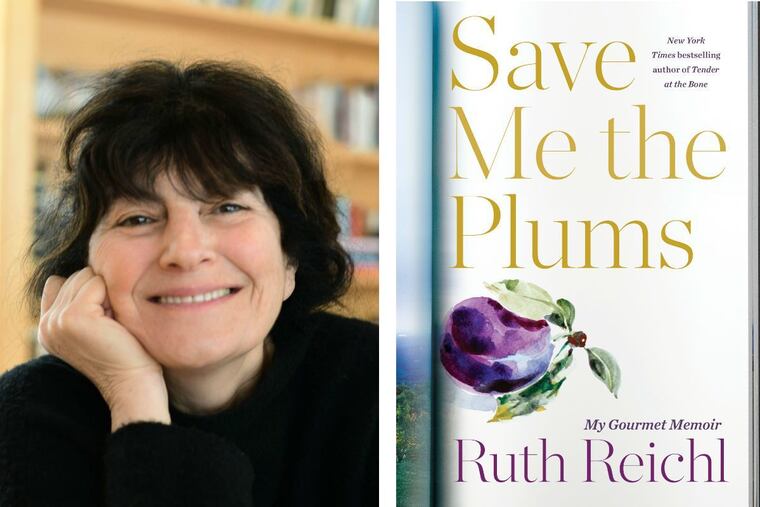‘Save Me the Plums’ by Ruth Reichl: The ‘debacle’ of Gourmet magazine, by one who lived through it
For a while, she was among the most powerful people in the Manhattan food world. But when that world began to change she tried to take the magazine with it, and management balked. Reichl is a born storyteller, best when she has fully developed characters living and eating well.

Save Me the Plums
My Gourmet Memoir
By Ruth Reichl
Random House. 266 pp. $27
Reviewed by Panthea Reid
While memoir writers must stick to autobiographical truth, they can freely borrow fictional techniques, as Ruth Reichl did in My Cooking Year (2015). Her ostensible subject in that book was the surprise closing of Gourmet magazine, where she’d been editor-in-chief for a decade. Her actual subject was her recovery through cooking.
In Save Me the Plums (2019), Reichl narrates the Gourmet debacle. At 8, she had been enraptured by tattered old copies of Gourmet. In a used book store, her father, a book designer, thrilled her by spending 50 cents on a Gourmet Cookbook. Adventures in book- and then food-shopping with her father read like passages from a novel.
Decades later, as food critic for the New York Times, Reichl held power over the Manhattan restaurant scene. When Gourmet offered to sextuple her salary, Reichl accepted. Husband Michael and their son Nick, as well as a poorly introduced half-brother and several female friends, supported her decision. Gourmet did not, however, finance a support staff, not even a fact-checker. Reichl had to manage with great energy but little sleep.
Reichl introduces a number of Gourmet characters. She has a formula for presenting them: a name with a professional identification and then a sentence about the appearance of each. I can’t recall which was the “tall, thin stork of a man,” whoever had “pale-blue eyes and windburned cheeks,” whose “pale, clever face was bare of makeup,” or who was “nicely dressed but without striking looks.” These markers attempt a fiction-like presentation but are forgettable, as these people were to Gourmet.
Reichl’s own ambivalence is a larger issue. A Condé Nast executive described Gourmet’s threshold for employment as appreciating luxury, but Reichl presents herself as a “dowdy” person who disdains luxuries. She was taken aback when Gourmet provided her with a huge dress allowance and a limousine. She insists that, as an unregenerate hippie, she prefers to ride the subway. We all navigate between insider and outsider roles in private and public lives. As she depicts her persona in and outside of Gourmet, Reichl, however, plays both roles at once.
She does narrate many great scenes. During the horror of 9/11, after she grabbed passports and terrified cats, Reichl left the city, panicked but relieved that Michael had taken Nick and some classmates into the unharmed countryside, where she soon made spaghetti for all. The next day, she returned to the city and, along with others in the restaurant world, began cooking for rescue workers, who were “covered in white powder” and looked like “ghosts staggering through the smoke.” Chili, cornbread, lasagna, and brownies fed hope.
In a happy scene, the sickly Nick, who would hardly eat as a child, suddenly develops a ravenous appetite, eating even sea urchin roe. Later, for a school project, he edited a cookbook and wrote an editorial rather like one of his mother’s. When Reichl secured the distinguished writer David Foster Wallace for a Gourmet article about Maine lobsters, she feared protests about boiling lobsters alive. After readers instead applauded “the edgiest article we’d ever published,” she learned that when “something frightens me, it is definitely worth doing.”
As the recession deepened, Reichl suggested a recovery issue: Paris on the cheap. She volunteered and wrote marvelous stories about restaurants on back streets offering three-course dinners for $25. Inexpensive hotels were no joy, but the “extraordinary” food was priceless.
Reichl became “Brand Ruth,” a television personality, award-winner, and honorary charity figurehead. Her account here lacks stories, as if she’s forgotten her own dictum in Tender at the Bone (1998): “The most important thing in life is a good story.” She scorns those at Gourmet who “thought they’d owned” the “exclusive little world of food.” They were losing out to ethnic restaurants and more diverse, inventive cooking. After the lobster article, Reichl insisted that they tackle other edgy food issues. The executives reacted.
In Reichl’s terms, they “murdered the magazine.” This seems to me not a tale of homicide or of losing out in the evolution of the fittest. Instead, it is yet another story of the unmerited demise of the controversial and provocative.
At the book’s close, Reichl is making German apple pancakes for her family, with a recipe for her readers. This is the homey, helpful, and buoyant Ruth Reichl readers love, who tells an unambivalent story about food as healing agent and redemption.